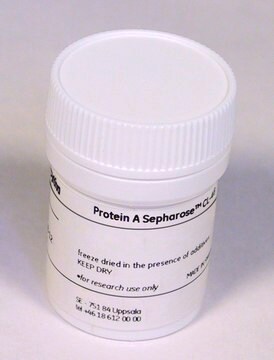16-156
Agarosio funzionalizzato con proteina A, ad alta scorrevolezza
Protein A Agarose, Fast Flow suitable for medium and low-pressure chromatography, immunoprecipitation and antibody purification.
Sinonimo/i:
Protein A resin
Autenticatiper visualizzare i prezzi riservati alla tua organizzazione & contrattuali
About This Item
Codice UNSPSC:
41116133
eCl@ss:
32160801
NACRES:
NA.56
Prodotti consigliati
Forma fisica
liquid
Produttore/marchio commerciale
Upstate®
tecniche
affinity chromatography: suitable
immunoprecipitation (IP): suitable
western blot: suitable
Condizioni di spedizione
wet ice
Descrizione generale
La proteina A è una proteina capace di legare le immunoglobuline (Ig) utilizzata per purificare grandi quantità di IgG. Si lega alla parte Fc dell'anticorpo all'interfaccia CH2–CH3. L′agarosio funzionalizzato con proteina A può essere indicato per l'isolamento di anticorpi a bassa pressione.
Proteina A ricombinante accoppiata covalentemente a microsfere di agarosio altamente reticolato al 6%.
Capacità legante: 40 mg di IgG umana/ml agarosio
Proteina A ricombinante accoppiata covalentemente a microsfere di agarosio altamente reticolato al 6%.
Capacità legante: 40 mg di IgG umana/ml agarosio
Applicazioni
L′agarosio fast flow funzionalizzato con proteina A è stato utilizzato nell'immunoprecipitazione e nell'immunoprecipitazione della cromatina (ChIP).
Qualità
Valutata abitualmente mediante immunoprecipitazione
Stato fisico
Acqua distillata sterile contenente lo 0,01% di tiomersale (thimerosal)
Note legali
UPSTATE is a registered trademark of Merck KGaA, Darmstadt, Germany
Codice della classe di stoccaggio
10 - Combustible liquids
Classe di pericolosità dell'acqua (WGK)
WGK 1
Certificati d'analisi (COA)
Cerca il Certificati d'analisi (COA) digitando il numero di lotto/batch corrispondente. I numeri di lotto o di batch sono stampati sull'etichetta dei prodotti dopo la parola ‘Lotto’ o ‘Batch’.
Possiedi già questo prodotto?
I documenti relativi ai prodotti acquistati recentemente sono disponibili nell’Archivio dei documenti.
I clienti hanno visto anche
Simon Schenk et al.
American journal of physiology. Endocrinology and metabolism, 291(2), E254-E260 (2006-05-04)
Although the increase in fatty acid oxidation after endurance exercise training has been linked with improvements in insulin sensitivity and overall metabolic health, the mechanisms responsible for increasing fatty acid oxidation after exercise training are not completely understood. The primary
Ghia M Euskirchen et al.
Genome research, 17(6), 898-909 (2007-06-15)
Recent progress in mapping transcription factor (TF) binding regions can largely be credited to chromatin immunoprecipitation (ChIP) technologies. We compared strategies for mapping TF binding regions in mammalian cells using two different ChIP schemes: ChIP with DNA microarray analysis (ChIP-chip)
Lei Jiang et al.
Investigative ophthalmology & visual science, 61(5), 41-41 (2020-05-24)
To identify the pathogenic gene of infantile nystagmus syndrome (INS) in three Chinese families and explore the potential pathogenic mechanism of FERM domain-containing 7 (FRMD7) mutations. Genetic testing was performed via Sanger sequencing. Western blotting was used to analyze protein
Yong Cheng et al.
Nature, 515(7527), 371-375 (2014-11-21)
To broaden our understanding of the evolution of gene regulation mechanisms, we generated occupancy profiles for 34 orthologous transcription factors (TFs) in human-mouse erythroid progenitor, lymphoblast and embryonic stem-cell lines. By combining the genome-wide transcription factor occupancy repertoires, associated epigenetic
Vasavi Sundaram et al.
Genome research, 24(12), 1963-1976 (2014-10-17)
Transposable elements (TEs) have been shown to contain functional binding sites for certain transcription factors (TFs). However, the extent to which TEs contribute to the evolution of TF binding sites is not well known. We comprehensively mapped binding sites for
Il team dei nostri ricercatori vanta grande esperienza in tutte le aree della ricerca quali Life Science, scienza dei materiali, sintesi chimica, cromatografia, discipline analitiche, ecc..
Contatta l'Assistenza Tecnica.









